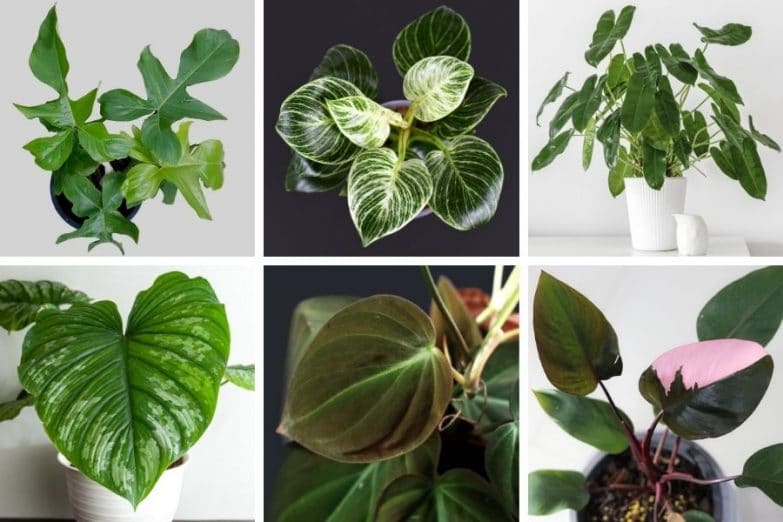If you’re fond of Philodendrons, you’re certainly not alone! There’s a lot to like: hardiness, robust growth, ease of care, simple propagation, and an incredible diversity of leaf shapes, colors, textures, sizes, and growth habits. Let’s check out 50 of the most beautiful Philodendron varieties making the charts – if you only know about the common Heartleaf variety, prepare for a big surprise!
Philodendron Varieties
The 17th century experienced “tulip mania” and the Victorians had “orchidelirium … today we’re seeing a frenzy for Philodendrons.
There are about 450 known species of this South American family and a confusing number of cultivars and hybrids. There are upright clumping and climbing forms, both of which are part of the “Aroid Fever” craze.
Some of the newer, rarer, or more in-demand Philodendron varieties can be difficult to track down, but there are so many amazing species and cultivars that lucky finds are everywhere. Searching is part of the fun.
Remember that most Philodendron varieties require the same basic treatment; as we go through the list, we’ll mention any particular care needed.
Philodendron Care
Part of the fuel for Philodendron mania is how easy they are to maintain. Certain species may have particular needs, but most have similar requirements. Once you learn how to keep one Philodendron happy, the door is open.
Philodendron care starts with warm temperatures and open, well-draining soil, that is kept slightly moist, but never sodden. Let the top inch or two of soil dry out before rewatering. Pay close attention to yellow leaves, a common sign of overwatering.
The plant does well in moderate to bright indirect light, but keep them out of direct sun. Darker-leaved Philodendrons can handle lower light, but variegated plants usually need brighter conditions.
As a tropical species, they do appreciate higher humidity, but most can adapt to average conditions. Modest monthly feedings with a balanced fertilizer during the spring and summer growing season are generally sufficient.
Philodendrons are typically resistant to pests (but not immune). One thing to remember: They are poisonous, so keep them away from pets and children.
If you’d like to get some of these beautiful Philodendrons, buying online is a great option. They ship really well and the variety available is so much better than anything I can find locally. Click here to see the beautiful selection of Philodendrons available from Etsy (link to Etsy).
1. Heartleaf Philodendron (Philodendron Hederaceum)
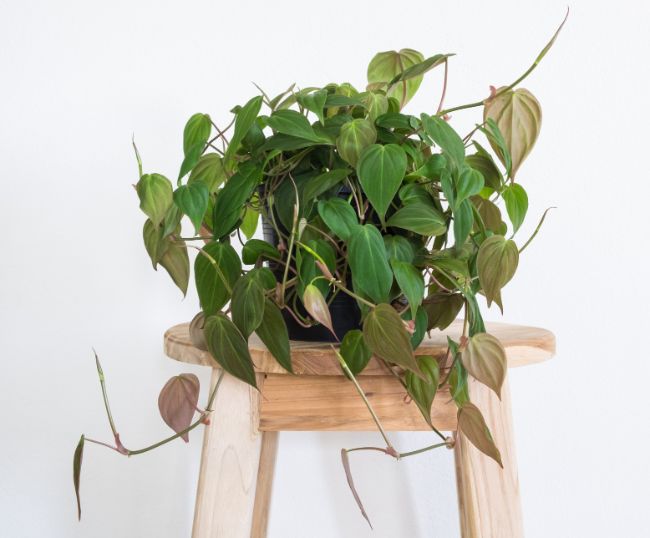
The trailing vines of this adorable Philodendron grace windowsills and hanging baskets across the world. It’s the classic beginner’s plant, adaptable to a range of light or humidity conditions, and forgiving of benign neglect (but not overwatering!). Read my Heartleaf Philodendron care guide for more info.
The Hederaceum’s fast-growing, heart-shaped leaves are two to three inches wide when trailing, but they can grow to over eight inches wide if allowed to climb. Juvenile forms may have lighter bronze-toned leaves.
The Heartleaf Philodendron makes a beautiful hanging plant with vines that reach four or five feet indoors. Multiple individual plants are often potted together for a fuller look. They respond well to being cut back if leggy or “bald” on top and propagate very easily.
Formerly called Scandens, Oxycardium, or Cordatum, the Heartleaf Philodendron is sometimes still sold under those names. There are many attractive varieties.
2. Philodendron ‘Lemon Lime’
This cheerful, yellow-green cultivar of the traditional Heartleaf Philodendron is perhaps less well known than it should be. It has the basic characteristics of the common Heart-leaved Philodendron and eye-catching foliage that deserves consideration for your collection.
The Lemon Lime color is especially impressive as a fountain of bright foliage cascading from a thickly planted hanging pot. This generous plant requires the same care as its classic cousin.
Note: The plant is sometimes sold under the name Golden Goddess … at a higher price.
3. Philodendron ‘Imperial Green’
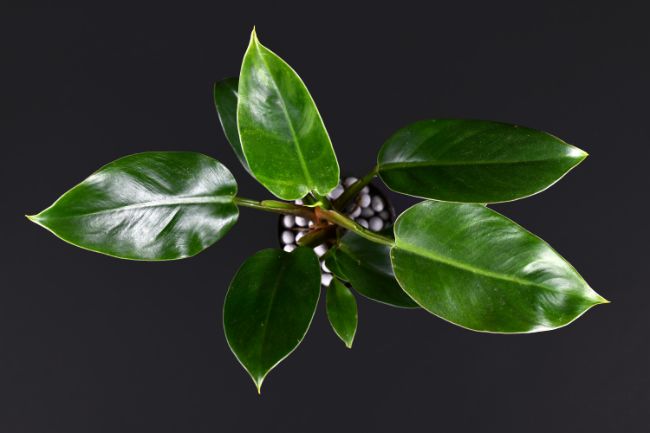
This spirited Philodendron is a vibrant green, bush-like plant with broad foliage that can grow to impressive dimensions – its close layering creates a grand centerpiece.
The plant will be happy with higher indirect light than most Philodendron varieties prefer. Though it can climb, many growers let the Imperial Green develop as a clumping shrub: new leaves emerge with a light color and darken with maturity, and the varying shades add interest when massed together.
Philodendron Imperial Green is widely available and is quite different than the ubiquitous heart-shaped Hederaceum: it makes an excellent specimen for a beginning collector. Check out the Imperial Red cultivar, too.
4. Philodendron ‘Prince of Orange’
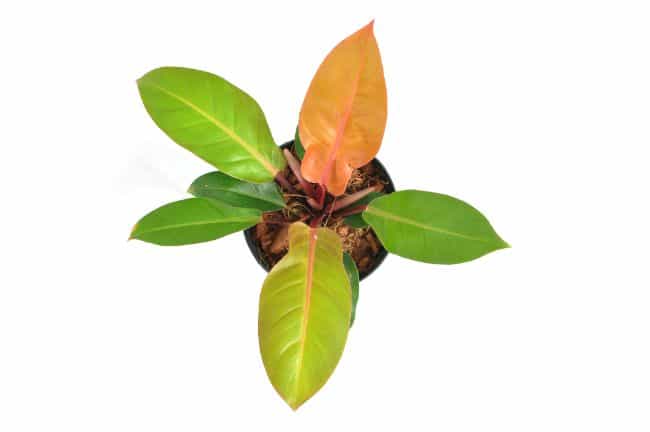
This is an especially cute and fun cultivar whose leaves emerge orange and turn light green as they mature. The petioles and new leaf spears are a colorful, deep red.
The Prince of Orange grows in an upright pattern that produces a tight cluster of leaves around a central stem. It stays tidy and doesn’t need staking, and can grow to a spectacular statement plant two feet high and wide. It’s hardy and thrives on regular Philodendron care.
This sweet hybrid is in wide circulation and is one of the most affordable exotic-looking Philodendron varieties on the market. You can buy Philodendron Prince of Orange online (link to Etsy) and have it shipped directly to your door.
5. Philodendron ‘Brasil’
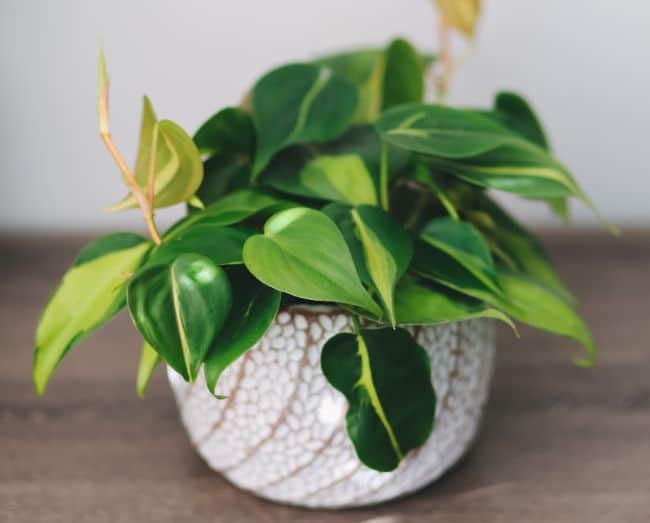
This too-often overlooked cultivar has a designer look but is so easy to maintain. The Brasil retains the hardy qualities of the common Heart-leaf and adds mesmerizing center strips of lime-green with randomly scattered yellow “painted” splotches across its leaves.
The Brasil can tolerate medium light, but it needs brighter conditions than most Philodendrons to maximize its lovely variegation. In low light it can revert to all-green.
The vines look great trailing from a hanging basket in any bright spot. The plant is easy to find and inexpensive … there’s nothing not to like!
6. Philodendron ‘Burle Marx’
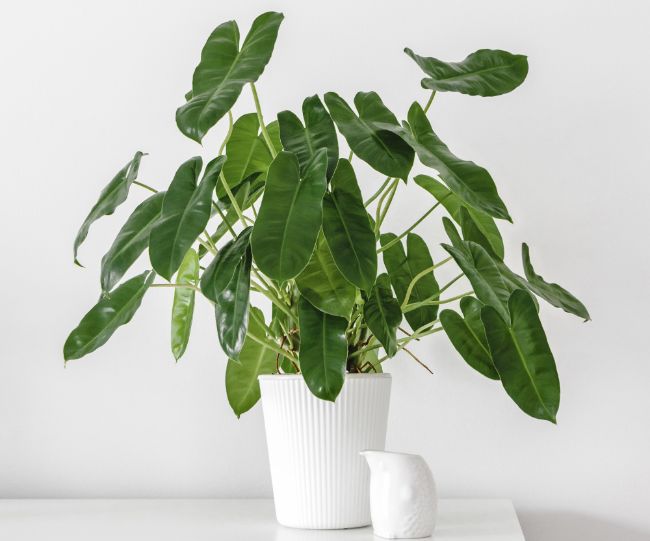
This vigorous favorite is a study in rugged elegance. The plant produces an abundance of elongated, paddle-shaped, shiny green leaves with deep lobes … the foliage undulates gently down its length and is marked with delicate pale veining.
Its upright growth style forms festive clumps of about two feet high and wide. The Burle Marx is hardy and prolific as a common landscape groundcover in warmer climates and prospers on typical Philodendron treatment when indoors.
The basic variety is affordable and easy to source. There are several prized variegated hybrids, including the mosaic-patterned ‘Burle-Marx Fantasy.’
7. Philodendron Xanadu (Thaumatophyllum Xanadu)
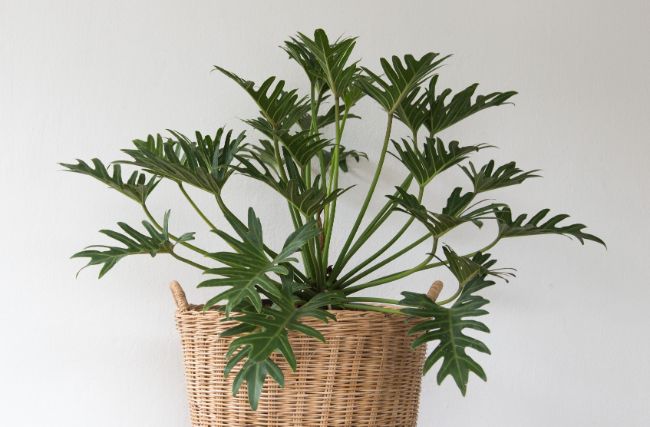
This upright-growing crowd-pleaser has recently been reclassed to a separate and very similar Thaumatophyllum genus, but it retains the Philodendron moniker as an official synonym. If you’re a Philodendron fan, this one’s too good to miss.
The plant’s broad, shiny leaves have multiple lobes – 15 to 20 per leaf – perched on long, sturdy stems. The plant is often wider than tall and tops out below four feet (there’s a dwarf Golden variety that reaches only a foot in height.)
The versatile Xanadu serves as a landscape groundcover in warm climates; indoors it thrives on a little extra bright, indirect light.
The Xanadu checks all the classic Philodendron boxes: it’s hardy and forgiving, easy to maintain, adapts to a variety of conditions, and provides tropical interest … plus it’s inexpensive and easy to find. I’ve written a separate article about caring for Philodendron Xanadu here.
8. Philodendron Brandtianum
The Brandtianum’s unique variegation attracts attention: each olive-colored leaf has a magnetic pattern of wide, silvery bands between its veins. Otherwise, it has a lot in common with the classic vining Heartleaf.
This popular Philodendron climbs and is fast-growing in good conditions. The plant is outstanding in a hanging basket or as a tabletop centerpiece with staked support. Also, Philodendron brandtianum is a great choice for dimmer spaces because it keeps its variegation in low light.
9. Philodendron ‘Moonlight’
This clump-forming hybrid stands out with electric, lime-green leaves – the broad, pointed foliage lights up any bright corner. New leaves unfurl a sunny, yellow color and gradually darken with age. New-growth shoots have shades of red.
Bright indirect light will keep the Moonlight’s foliage vibrantly fluorescent; also, let the soil dry halfway before watering. It’s a fast-grower that doesn’t need support: it forms a small shrub that typically stays under two feet high.
A similar but rarer cultivar called a ‘Red Moon’ has similar variegation.
10. Philodendron Pedatum
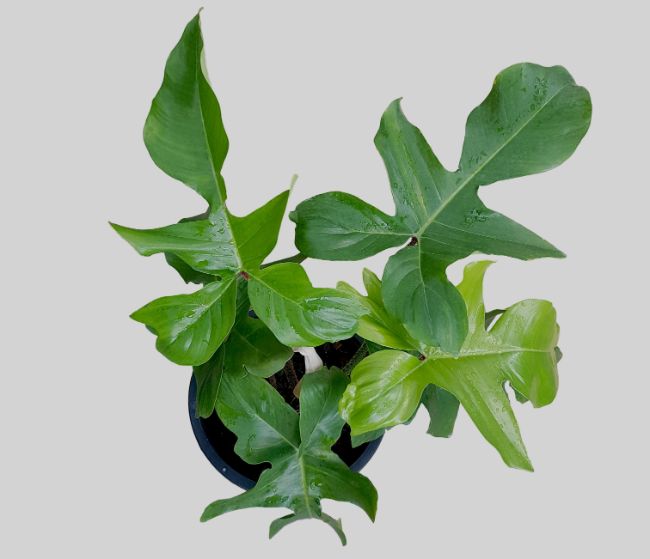
Sometimes called an Oakleaf Philodendron, this unusual climbing plant has green leaves that change shape with maturity: they start small and oval, and develop deep lobes as they grow, finally reaching up to nine inches long.
The Pedatum is a climber with an exotic, airy, open structure that can grow well over three feet tall. It’s hardy and evergreen indoors; it flourishes with normal Philodendron care. Clean its leaves periodically to help it breathe and ward off pests, and the leaves will naturally shine.
If you’re intrigued by interesting leaf shapes, check out Quercifolium for an even more extreme example of deep lobing.
11. Philodendron Micans
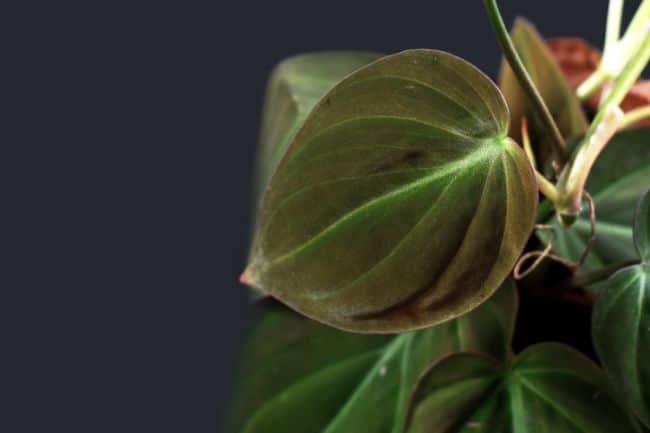
This handsome Philodendron has trailing vines of heart-shaped tropical leaves with tiny hairs that give them an almost iridescent hue. The foliage looks different according to how the light hits it, ranging from dark to light green or even bronze. Young leaves have reddish undersides and a velvety texture; they become smooth as they mature.
Philodendron Micans makes a wonderful hanging plant in a bright window out of direct sun. The plant grows quickly with typical Philodendron care, though it benefits from drying out a bit more between waterings. Its vines reach about six feet in length.
This used to be a hard-to-find plant … as it’s become popular and more available, the price has dropped. You can buy Philodendron micans here.
12. Philodendron Bipennifolium
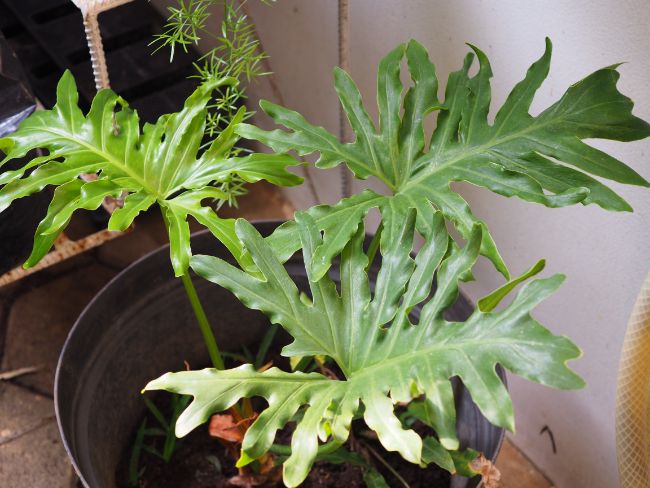
This large climber has trippy-looking leaves that can grow over a foot long and have an interesting, horse-head appearance. It’s one of the most common and popular Philodendron varieties that are specially prized for their leaf shape.
This moderately fast-growing plant looks best staked to keep it from flopping. It grows rather large, so you’ll need some space. The leaves actively turn to the light, so rotate the plant periodically to keep it balanced.
There are several color varieties, including bright yellow-hued Aurea, the blue-gray Glaucous, and other variegated forms. One particularly sought-after hybrid is the Green Dragon, which has a head that looks like a …
13. Philodendron Birkin
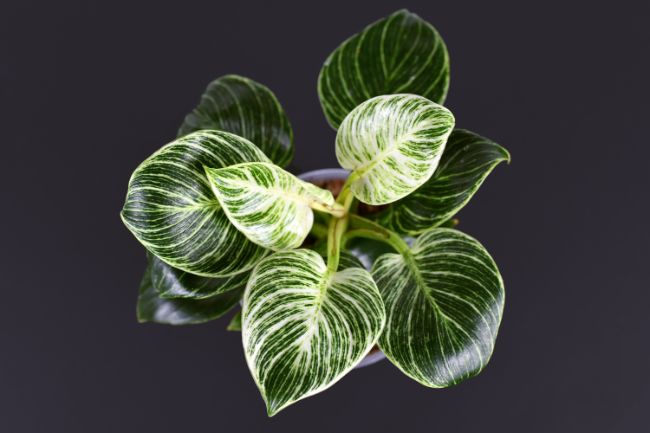
It’s easy to see why Philodendron Birkin helped spark Philodendron mania. The pin-stripe variegation over a dark green background has a striking radial pattern, and its natural variability means every leaf is a bit different – it’s fun to see how each one turns out! This is an entertaining plant that stands out in any setting.
Though it looks like a designer diva, the Birkin is as low-maintenance as most Philodendrons. The compact plant isn’t fast-growing but can eventually reach two feet high or more.
Philodendron Birkin is susceptible to root rot, so ensure it has well-draining soil that dries halfway before rewatering. Don’t let it dry out completely though!
Be aware that the Birkin is a “spontaneous chimeric mutation” that can put out leaves with aberrations. It’s being propagated widely through tissue culture and prices have dropped significantly.
14. Philodendron Hastatum
This bold variety has long, arrowhead-shaped leaves that can grow up to nine inches wide and almost two feet in length; its vines can reach over 10 feet long. The foliage is gray-green with a metallic sheen. It does well indoors or out and can commandeer an empty space or mix well with others.
Though it’s a rather thirsty plant, the Hastatum is subject to root rot: keep its pot snug and consider a terra cotta container that breathes. It responds well to being pinched back early in the season.
Incidentally, Philodendron Hastatum is an endangered Brazilian plant in the wild … but it’s such a popular houseplant that its existence is not threatened. It’s nice to know gardening has a positive role in wildlife preservation!
Commonly called a Spadeleaf or Silver Sword Philodendron, its official taxonomy is a bit confused: the plant is erroneously labeled a Domesticum, Glaucophyllum, Elongatum, or Hastifolium (and possibly others). There’s a narrow-leaf version and several variegated hybrids including Silver and ‘Lemon Lime’.
15. Philodendron ‘Florida Ghost’
All of us would like to be as much in demand as this eye-catching hybrid. It puts out highly variegated foliage that ranges from a hazy, mottled green to a full-leaf creamy white: each specimen is different. The Ghost is also interesting for its red, roughly textured petiole.
The plant is a shape-shifter that changes form and color as it grows. Irregular oval young leaves develop a set of shallow “arms” which mature into deeply cut lobes.
The Ghost is a hardy plant, but it needs stronger light than other Philodendrons to bring out its variegation. Sometimes it’s sold as a separate variety called Florida ‘Mint’ Ghost, but don’t be fooled – it’s just a regular Ghost grown in lower light!
The plant is thought to be a hybrid of Philodendrons Pedatum and Squamiferum. The Alba Beauty is another popular Florida strain with broad, green leaves.
16. Philodendron ‘Green Congo’
This bushy Philodendron features stiff, slightly elongated, heart-shaped leaves that grow thickly from a central stem. It makes an excellent tropical centerpiece and needs little shaping to stay attractive and full.
The low-maintenance Congo loves warmth and should be protected from cool temperatures below 41ºF (5ºC). There is an especially popular ‘Congo Rojo’ cultivar with variable green, red, and burgundy leaves.
You may not find the Congo in a local nursery, but they are widely available online.
17. Philodendron ‘Thai Sunrise’
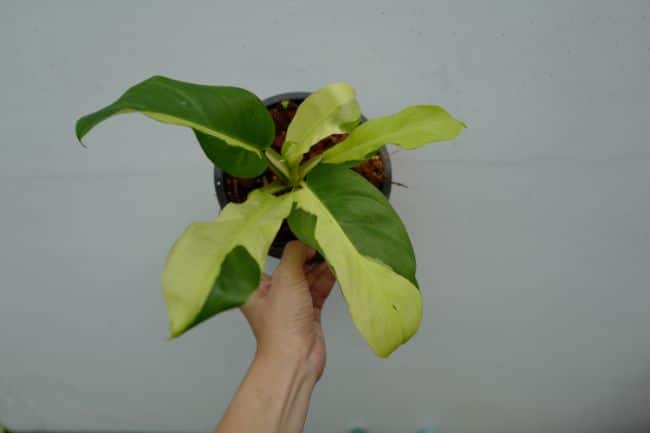
This splashy hybrid has elongated, paddle-shaped leaves with a lime green background and variable dark green margins. Each leaf has its own yellow-colored stem that displays a red gradient on the upper end.
This popular and easy-to-maintain variety grows from a central jointed trunk. It stays compact as a stunning accent or tabletop plant.
Though the Thai Sunrise has gotten more expensive, it’s not too hard to find. It ships pretty well and bounces back with some TLC.
Note: From this point on, finding a specimen begins to become an interesting challenge and prices start to jump. The next few varieties aren’t too budget-busting … but brace yourself.
18. Philodendron Black Cardinal
If you’re a lover of dark leaves, the Black Cardinal Philodendron will blow your mind – it may do that anyway. Its large, pointed, paddle-shaped leaves are deep burgundy to almost black; the stems glow red. New foliage is a pinkish hue and darkens with age.
Black Cardinals have an upright growth pattern with thick, bushy growth. The plant needs standard Philodendron care, but don’t give it too much light; an excess can fade the imposing leaf color.
This Philodendron has the exotic look of a rare variety, but it’s widely available and definitely adds a dimension to your collection. There are variegated forms, but that may be missing the point of this plant.
19. Philodendron Mayoi
This is a tough little Philodendron with perky, multi-lobed foliage – unusually, its leaves remain medium-sized even as the plant matures. The strong, stout stems wind into interesting shapes as it grows.
The Mayoi is often grown loose without support, but it can become a determined wanderer if you don’t let it climb. It grows quickly in good conditions and thrives on a normal Philodendron regimen. The stems can become gangly in lower light and will stretch towards a source.
The plant isn’t in the center spotlight but is quite popular with its owners: the Mayoi has a lot of in-person character. There is some controversy about whether it is very similar or exactly the same as the “Tahiti” Philodendron.
20. Philodendron Grazielae
This rounded, fresh-faced variety offers an intriguing take on the classic vining Heartleaf. Its chunky leaves are an energizing, glossy green. The foliage remains modestly sized on sturdy stems.
The plant’s centralized growth pattern gives a young specimen a bushy appearance, but the vines need support as it grows. The Grazielae is easy to maintain with normal Philodendron care, but it’s not a fast-grower and can’t tolerate cold weather.
It’s a cheerful, unusual plant that’s becoming more popular and is well worth a look.
21. Philodendron Melanochrysum
The Melanochrysum, aka the Black Gold Philodendron, is a favorite of many collectors and one to consider if you favor dark-leaved plants. It resembles a large Micans: the foliage is deep, dark green – almost black – with gold crystalline flecks buried throughout the surface.
As a juvenile, the plant is a creeper with small, oval, reddish leaves. The foliage darkens and becomes velvety as it matures, eventually growing up to two feet long! The adult form is a climber and needs support to grow: it tops out at four feet or more.
The Melanochrysum needs a bit more attention than typical Philodendron varieties and won’t accept soggy soil. Not that difficult to find, but quite pricey.
22. Philodendron Gloriosum
This Columbian native is a sought-after signature Philodendron boasting a contrasting vein structure that showcases the plant’s enormous heart-shaped leaves. The velvety foliage can reach three feet wide in nature, although it’s a bit tamer indoors.
Emerging leaves unfurl with delicate pink veins that fade with maturity. The Gloriosum has a creeping rhizome and grows low to the ground, giving it shorter, tidier internodes than unruly Philodendrons with splayed foliage or tangled vines.
The plant is an easy keeper, but it won’t tolerate cold or wet feet. It looks a bit flimsy when young but becomes stronger and more attractive as it grows … it’s magnificent as a large specimen.
23. Philodendron ‘Bob Cee’
This trendy hybrid is an imposing statement plant that’s caused a lot of recent buzz. It conjures a tropical vibe with dark green, deeply lobed, “toothed” foliage that juts from atop tall stalks.
Young leaves start out with shallow lobes which deepen into a pinnate form as it matures—each can grow to over three feet in length. It’s a climber, too: its thick, snaking center vine adds to the jungle effect.
A very easy Philodendron to maintain, word has gotten around about the Bob Cee and specimens are becoming increasingly available.
24. Philodendron Mamei
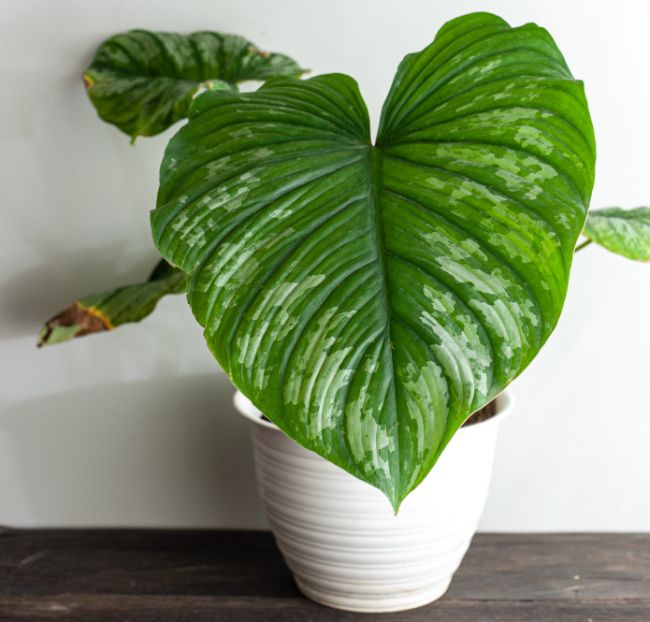
This terrific creeping Philodendron keeps its attractive, highly-variable silver leaf colors throughout a leaf’s lifespan. The thin, semi-glossy foliage is broad and heart-shaped with vein indentations that gives the leaves a charming rippling texture. The cataphylls are dashes of red color.
This is a low-growing species; each of its large leaves is supported by a single stem and reaches 10 to 18 inches wide.
The Mamei is pricey but not too hard to find online. Most available plants are propagated by tissue culture and may stay a bit smaller.
25. Philodendron Martianum
This lovely epiphytic tropical doesn’t look much like a typical Philodendron … its chunky, swollen petioles support a thick centralized profusion of strap-shaped leaves. The vibrant green, glossy foliage has an almost succulent appearance.
The Martianum is hardy under good light and is easy to keep. Just be careful not to overwater this plant! It is subject to root rot, so extra-porous soil is a good idea; if you keep the plant on the dry side, the leaves will be smaller but the petioles will swell.
This uncommon Philodendron is a conversation-starter that adds something different to your collection.
26. Philodendron Lacerum
The large, semi-glossy leaves of this handsome climber have multiple lobes around their edges that give them a showy, fringed look. The leaves are shades of gray-green and are indented by thick veining. The glossy undersides are darker.
A Caribbean island native, the Lacerum can be either an epiphyte or a hemiepiphyte – either way it wants to live in a tree. You should let this one climb; and, it will need space.
The Lacerum likes brighter light than some Philodendrons, but it’s easy to keep happy. Though somewhat rare they carry a relatively reasonable price, at least for now.
27. Philodendron Painted Lady
This well-known Instagram star is a hybrid with neon yellow variegation on its mid-to-large sized leaves. New foliage emerges a bright yellow-green and gradually deepens to a dark green background. Each leaf retains lively mottling at each stage. The petioles are pink or bright red.
The Painted Lady is a climber that will produce larger foliage as it grows higher – mature leaves can be over a foot in length. It does well with regular Philodendron care, but it tends to like being on the drier side.
Due to its durable popularity, the plant isn’t too hard to find … but they don’t give them away.
28. Philodendron Tripartitum
Tri-leaved Philodendrons are having a moment, and this is one of the most popular and less extreme types. The leaves’ three-part construction on long stems is simple, balanced and clean. The plant provides a less tropical and more “woodland” appearance than most Philodendron varieties.
The plant can trail but it really loves to climb; it will reward your support with even larger leaf sets. Additional humidity is welcome, but it won’t complain much.
If you’re a tri-leaf fan, you have many choices – Philodendrons Augustilobum, Fenzlii, Anisotomum, Bipennifolium, and the captivating Green Dragon hybrid, to name a few.
29. Philodendron Melanoneuron
This Ecuadorian native has wonderfully textured, classic heart-shaped leaves much larger than more common varieties. The glossy, green foliage is deeply ridged with a pale midrib and lateral veins that emboss its surface.
The Melanoneuron enjoys climbing a support and is happy with normal Philodendron. care. It’s a moderate grower that can grow quite large, but it responds well to being trimmed back.
It’s highly desirable collector’s plant that can be hard to find. It’s not like they grow on trees … oh, wait.
30. Philodendron Mexicanum
This Mexican native has an intriguing leaf structure. Their large leaves are narrow and triangular and develop long lobes on the back of the leaves as they grow. These lobes fall over like a “dog-ear” so that mature leaves become three dimensional.
This vining Philodendron can become a bit straggly if left to trail and will benefit from climbing support: it will be more contained and the leaves will grow larger, too. The plant grows steadily and can reach over six feet in length.
The Mexicanum prefers brighter light than most Philodendrons and doesn’t mind drying out (briefly) between waterings. It can extrude “happy sap” from the upper petioles to attract ants – a natural protection against pests – so shield your furniture and carpet. The sap is harmless and can be washed off easily.
31. Philodendron Bernardopazii
The shiny, triangular leaves of this spectacular Brazilian aroid grow up to two feet long. Pale veins stand out on the vibrant green foliage. It’s a classy show plant with upright, draping growth that looks good at any size.
Morning sun is good for these beauties. Their foliage is thought to grow more narrow in brighter light. It’s fairly prolific and easy to care for.
The Bernardopazii was formerly called the “Santa Leopoldina” due to its original locale, and later termed Superbum until finally being awarded its current title. It’s sold under any of these names.
The narrow-leaved variety of this plant is an attractive substitute, or “dupe,” of the impossibly rare Spiritus Sanctii, but the wider form is more common.
32. Philodendron ‘Majesty’
As the name suggests, this is a Philodendron that commands attention: it’s one that lovers of dark foliage need to check out. It has large, dark, purplish-green ovoid or pear-shaped leaves; the undersides of the foliage and new growth spears are burgundy. The plant has a swank matte finish.
Her Majesty can climb and grow larger leaves as the vines extend upwards. Though it’s not fussy, this is a fairly rare hybrid that’s priced accordingly. If you’re good with cuttings, they can be an avenue to ownership without mortgaging your greenhouse.
Another dark-leaved favorite, Dark Lord, is similar but even rarer: it has smaller sinus gaps and lobes on the leaves.
33. Philodendron Camposportoanum
This charming little shape-shifter is a desktop Philodendron with lots of personality. Its juvenile leaves are dark and velvety and become more heart-shaped and develop long rear lobes as they grow. At maturity, the plant produces flamboyant three-lobed foliage that can reach almost eight inches in length – it looks like a totally different plant once fully grown.
The foliage features reddish tints mixed into the green pigmentation: in bright light, the leaves can shine with stunning pink highlights. The Camposportoanum likes to climb but stays small.
Give it normal Philodendron care with higher humidity if you can. It’s a great terrarium plant. Happy hunting!
34. Philodendron Squamiferum
This rather uncommon Philodendron really brings the jungle indoors. The bold, oak-leaf style foliage has deep lobes and can grow almost two feet long … its long “furry” stems are covered with unique, distinctive red bristles.
The plant is attractive when small and, though it can grow to the ceiling, is a moderate grower that won’t quickly take over a room. Plan to give your Squamiferum a pole or trellis to keep it on display. It’s undemanding and does well with standard Philodendron care.
Squamiferums are not the easiest plant to find, but they have a lot of presence and make an impressive tropical backdrop for any collection.
35. Philodendron Verrucosum
This exotic, velvet-leaved plant has a lot going on. It features broad, heart-shaped foliage patterned with swathes of light veins over a dark green background. The undersides of young leaves are often yellowish and have a red blush between the veins; older leaves fade to a more uniform green. Mature petioles are thick with fuzz.
The Verrucosum isn’t too picky, though it favors humidity. It prefers medium-to-low light and is a climber that needs support. The plant doesn’t like change and often doesn’t ship well, but bounces back with some TLC.
Since it propagates well from cuttings, it has become a common way to obtain this highly in-demand plant at a discount.
36. Philodendron Subhastatum
This two-faced beauty looks like a typical broad-leaved green tropical Philodendron from the top, but it’s a different story once its red-hued underside is exposed. The upright foliage flashes both bi-colored sides in a charismatic effect.
The Subhastatum is robust and typically easy-going. It likes to climb and can grow quite large with proper support.
It’s a fresh face that’s become popular in recent months and remains possible to find … for now.
37. Philodendron Plowmanii
The striking texture on this creeping Philodendron stands out – the large, heart-shaped mature leaves have conspicuous undulations across its surface. The adult’s vein indentations are deep and give the thin leaves a sculptural appearance.
Each petiole is the stem of the plant complete with a root structure; dramatic, over-the-top ruffled edges run along it. Juvenile specimens show a silver coloration which fades in adulthood. Mature leaves can display both green and yellowish hues.
Its special features and easy care requirements have made the Plowmanii quite hot on the market. Small plants can be costly, but they’re generally not too hard to locate … it’s best to forget about full-sized specimens.
38. Philodendron Atabapoense
This South American climber has been getting well-deserved attention. Its thin, elongated, sword-shaped leaves have a leathery texture and maroon undersides. The foliage widens as it grows to approximately two feet in length.
The distinctive foliage is impressive whether climbing a support or draping from a hanging basket. The Atabapoense is easy going and grows moderately quickly in porous soil.
The plant’s narrow juvenile form looks similar to the rare Spiritus Sanctii, which isn’t helping to cool off demand. Finding a small plant and growing it up is a more viable plan than looking for a mature specimen.
39. Philodendron Billietiae
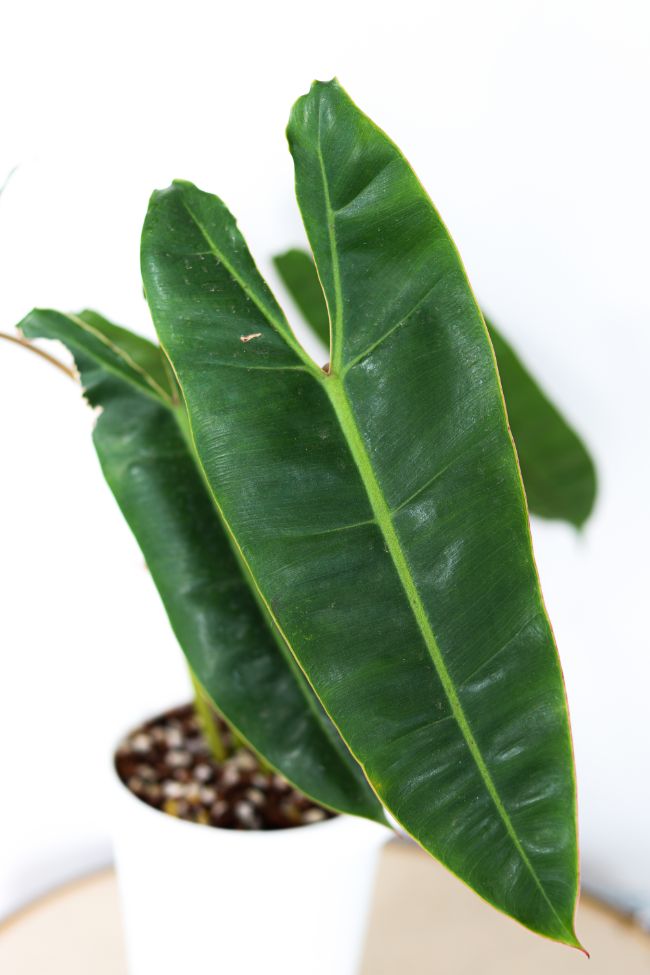
If long, narrow leaves are your thing – as it is with many growers – the Billietiae is one to pine over. The thick, leather leaves are rippled and grow up to three feet long and 10 inches wide. The pale center and horizontal veins make an arresting contrast against the deep green leaves.
The Billietiae doesn’t stop there! It also has long, pale orange stems … though these can fade with age or lower light. The plant grows upright early in life and switches to sprawl mode as it matures and starts searching for a tree to climb. It thrives with routine Philodendron care.
This plant was only discovered in 1995 and has recently hit the pop charts, so it can be difficult to find. Black and variegated cultivars are available too.
40. Philodendron Pastazanum
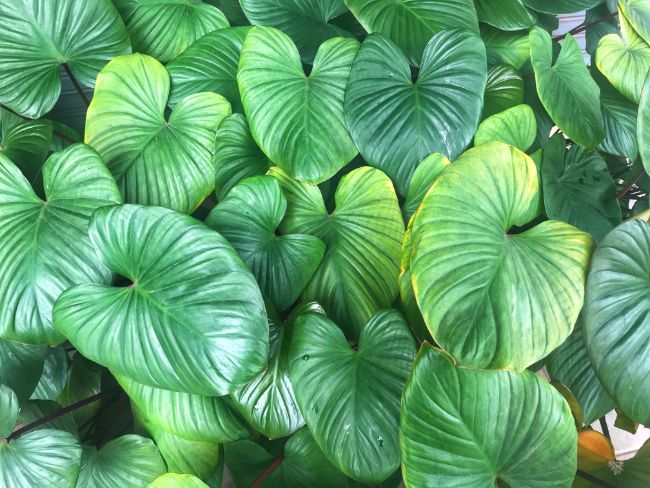
This charming, low-growing, uncommon Philodendron features oversized, broad, heart-shaped leaves with pale veins that perch on long, graceful stems. Its verdant, textured leaves seem like they belong on a much bigger plant and can spread to over foot in breadth.
Emerging stem shoots are red and unfurl into well-developed leaves. Its creeping rhizome benefits from a rectangular container to grow naturally.
There is a variegated specimen called the Silver Pastazanum. Both require normal Philodendron care. Neither is widely available.
41. Philodendron Callosum
Another unusual creeper is the thick-skinned Callosum – though “thick” is an understatement for the rough, bumpy, stiff texture of these tough-skinned leaves. The foliage is strange in other ways, too: each elongated oval leaf has its own long, curvy stem, and the leaves jut out at an unnatural angle from the stem.
The plant is easy to maintain with standard Philodendron care. Watch out for the harmless but sticky “happy sap” they emit; protect vulnerable furniture.
As a bonus, the bulbous inflorescences are one of the most lovely in the Philodendron world: its center pink-and-white spike is surrounded by a cream-colored cup.
There are three forms with slight differences, but the plant is rare enough that any of them is a find.
42. Philodendron Ring of Fire
This exciting collector’s hybrid features long, narrow leaves with serrated “flaming” edges. The foliage emerges from a central trunk on individual stems which can each grow to two feet long.
The leaves have random orange, red, yellow, green, and cream or bright white variegation – the flickering effect gives the plant its name. It’s rather slow-growing; part of the excitement is waiting for each unfurling leaf to reveal itself.
This plant isn’t so hard to find as it is expensive … tissue culture is making it more plentiful but can’t keep up with demand.
43. Philodendron Tortum
You’d never guess this funky plant was from the Philodendron family. Its palm-frond growth pattern and thin, twisting, skeletal green leaves add a dramatic structural element to any collection.
Juvenile plants are climbers, but once maturity sets in the plant becomes compact with a unique claw-like profile. New leaves have a delicate pink cast.
This odd plant is a more insistent on having extra humidity than most Philodendrons, but they’re easy to please overall.
Though pricey, the Tortum isn’t too difficult to track down.
44. Philodendron ‘White Wizard’ and ‘White Knight’
These elegant vining Philodendron varieties have been around a while but were caught in the updraft of recent demand. They are brilliant beauties, no question, but not quite as “rare” as prices seem to indicate.
One glance shows you what the buzz is about: the heart-shaped leaves are spectacularly variegated with blocks of dazzling white against shades of solid green. Leaves can have white strips or be halfway or even completely white.
These plants are slow climbers – unlike their recent prices – so most sale pics are of small plants, but these hybrids can grow several feet high with support. They look similar, but the White Wizard has green stems while the Knight’s are reddish to dark purple and white.
45. Philodendron ‘Pink Princess’
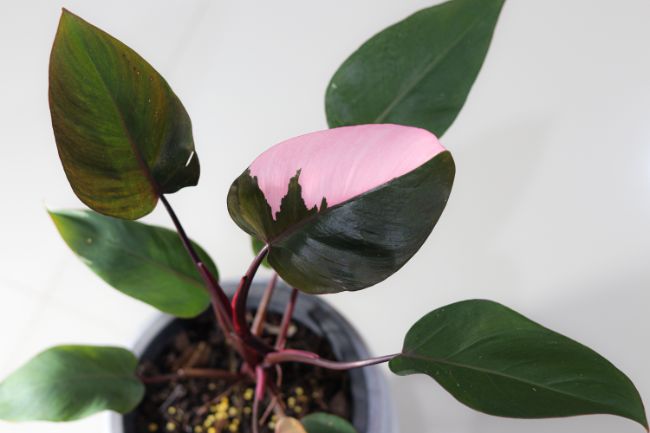
Arguably the plant most at the center of recent Philodendron mania, this Blushing Erubescens looks much like the lovable common heart-leaved variety – with one important difference: the foliage is variegated with random pink swashes. Color can vary in intensity from cream to tints to full-on hot pink.
The dark green to deep burgundy foliage provides a royal contrast with the pink variegation. The plant can either climb or cascade from a hanging basket with leaves that grow up to 8 inches long.
The Pink Princess is a slow grower and bit fussier than most Philodendrons. It has an aversion to cold and needs bright indirect sunlight to stay its glamorous best. Propagation is easy, but select material with good variegation: the plant can revert to all-green if grown from cuttings that lack color.
If you like the variegation style, the White Princess is even hotter on the market. Approach carefully with an open wallet.
Be aware that another plant, the Pink Congo, is treated to produce temporary pink coloration: unscrupulous sellers have charged high prices for the fake without informing customers.
46. Philodendron ‘Jose Buono’
This fashionable hybrid features large paddle-shaped leaves emerging from the plant’s center on thick, succulent-like stems. The thick foliage is dark green with flamboyant splashes and full, chunky sections of lime green.
The Jose Buono grows quite large: outdoors it can reach a massive ten feet in height and width, though indoors it reaches less than half that size. The plant’s leaves are gorgeous even in death: discontinued leaves become a glowing yellow color mixed with remnants of green.
The Jose Buono is quite robust and requires only basic Philodendron care. Its availability has increased recently, but it’s a hot property and prices are still in the stratosphere.
47. Philodendron ‘Paraiso Verde’
This is a uniquely variegated hybrid people lose their minds over. Its long, deeply lobed, paddle-shaped leaves are splendid canvasses of multicolored green shades splashed in unpredictable patterns.
With its aerial roots and staggered leaves, the plant can look a bit messy, but it’s a beautiful mess. The foliage varies: some leaves will appear mosaic or finely mottled, others will feature bands or splotches of color. Variegation is affected by light and soil conditions.
The Paraiso Verde is an easy-to-care-for Philodendron – the hard part is getting your hands on one.
48. Philodendron Sharoniae
The elongated paddle-shaped leaves of the Philodendron Sharoniae have spectacular pleated horizontal ridges and a high-drama, drooping growth pattern. The foliage can grow up to three feet long but stays a modest size indoors.
This tropical mammoth is easy to care for in well-draining soil … but who are we kidding? We’re just gawking now. This gorgeous collector’s plant may be everything you want in a botanical child – but good luck finding one, much less affording it!
49. Philodendron Joepii
This bizarre specimen is absurdly rare in the wild – only two have ever been found. The plant may actually be a natural hybrid, but it hasn’t been officially identified.
The most normal thing about the foliage is that it emerges yellow, turns green, and grows over two feet long. Otherwise, each leaf flies on a single long, stout stem like an alien kite with a skinny middle and bulbous ends, and is topped by a pair of leafy “antennae.”
The plant’s discoverer first thought it had been eaten by insects, but no: it looks that way naturally. And collectors love it! This ugly duckling has hit the big time.
The Joepii was formerly confused with another Philodendron known simply as a 69686. Intensive propagation is gradually making the plant more available, but don’t expect to see them in hardware stores any time soon.
50. Philodendron Patriciae
Our final selection is a show-stopper with large, vertically-hanging paddle leaves. The elongated foliage has a glowing central vein and is gently rippled with curvy undulations. Each leaf grows up to four feet long and lasts up to three years.
The Patriciae thrives on regular Philodendron care but is a bit touchy about being moved. They like regular feeding; high temperatures can bleach their leaves. It’s a climbing specimen that needs support and, like its price, can grow through the roof.
There would probably be more demand for this plant if it could be found – if you do locate one, your likely reward will be sticker shock. Note that long-leaved look-alikes may be substituted by mistaken or disreputable retailers, so take precautions.
Bonus: Philodendron Spiritus Sanctii
You’ve made it to the end of this botanical rainbow of Philodendron varieties, so you may be interested in knowing the rarest and most sought-after Philodendron of all: the breathtaking Spiritus Sanctii.
This draping angel haunts collectors not only for its large and beautiful hanging foliage but because they are unicorns of the plant world.
There are said to be about six wild Sanctii specimens in the wild; they grow slowly and don’t propagate easily … nonetheless, they’ve ignited a craze for narrow, drooping foliage. We may never see this plant outside our dreams – or social media – but isn’t that what Holy Grails are for?
If you’d like to purchase any of the beautiful Philodendrons on this list, I’d highly recommend buying online. Most Philodendrons ship really well and the variety available is so much better than anything I can find locally. Click here to see the beautiful selection of Philodendrons available from Etsy (link to Etsy).

